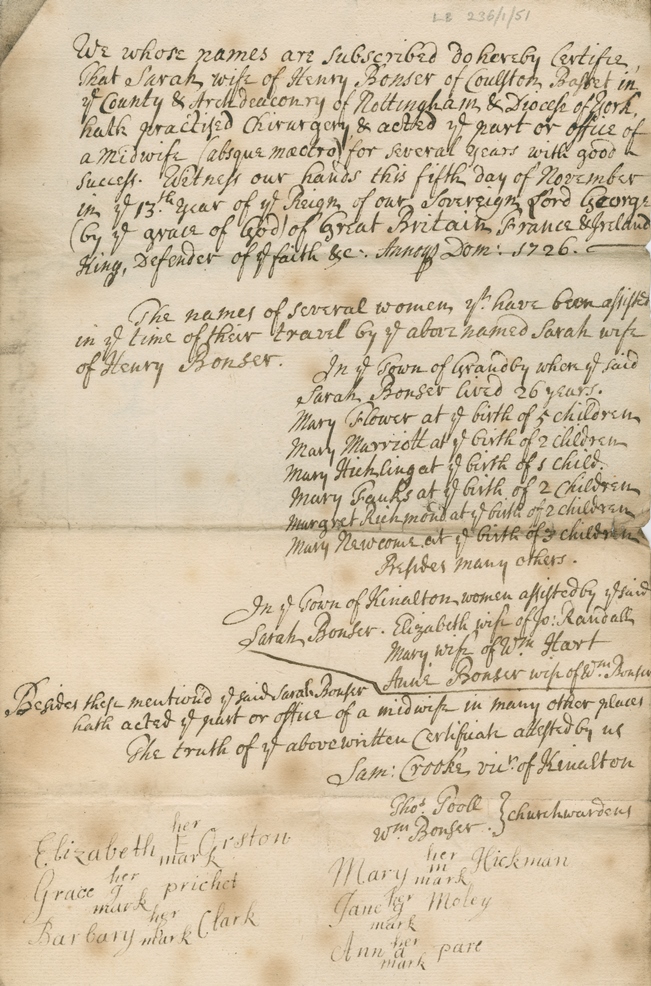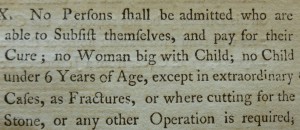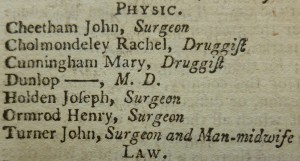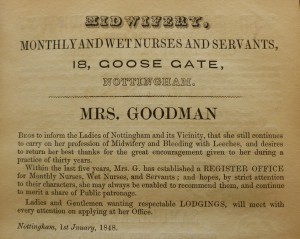
May 2, 2015, by Kathryn Steenson
One Born Every Minute
As William and Kate welcome their baby daughter into the world at the state-of-the-art private maternity ward The Lindo Wing of St Mary’s Hospital, we had a look back through our collections to see what childbirth was like in the 17th and 18th centuries.
Traditionally, pregnancy and birth were social and domestic occurrences, which predominantly took place in the home, with advice and assistance provided by friends, family and neighbours. This attitude persisted long after general hospitals began opening in England during the 18th. When Lincoln County Hospital opened in 1776 and Nottingham General Hospital in 1781, neither admitted pregnant women or children, because it was believed that they should be cared for at home.

‘Statutes and Rules for the Government of the General Hospital near Nottingham, Open to the Sick and Lame Poor, of any County’; 1783 (Ref: Uhg Ru/1)
The term midwife is derived from the Middle English ‘midwyf’, meaning ‘with-woman’, as in someone who is with the woman (mother) during the birth. Many midwives learned their skills through assisting more experienced midwives in a type of informal apprenticeship, although if they were elder daughters, it’s likely that they would have already been present at the births of younger siblings or cousins before this stage.
For many centuries midwives were trusted and respected members of their local communities. The Church had licensed midwives from medieval times, and could bring women before the ecclesiastical courts for practicing without a licence. Baptism is the only sacrament that can be administered by a lay person in an emergency. Sadly, midwives were likely to be in a position where this was considered necessary, and therefore it was important that they were considered respectable people by the Church.

Certificate of Sarah Bonser, midwife of Colton Basset in Nottinghamshire, stating that she has practised midwifery for ‘several years with good success’ and listing the women she assisted. The certificate is signed by the Vicar and Churchwardens of Kinoulton, 1726 (Ref: AN/LB 236/1/51)
Midwives were not required to be literate and never read the published texts that described the best way to manage complicated labours, and which instruments (such as forceps) were available to help deliver babies. These were written for male doctors and ‘man-midwives’, who were only summoned when the life of the mother and/or baby was in danger. Dr Percival Willoughby (1596-1685) was one of the earliest English man-midwives to write about his work in the midwifery practice he established in Derbyshire from 1631 to 1672. His Observations on Midwifery cautioned against interference and the over-enthusiastic use of instruments.

‘Man-midwife’ listed in ‘The Universal British Directory of Trade, Commerce and Manufacture’, 1793 (Ref: EMSC Not 1.B15.D93)
It wasn’t until the 19th and 20th centuries that childbirth became a medical issue involving doctors, hospitals, and formalised training. From 1886, doctors were required to qualify in midwifery as well as surgery and medicine before they could practice, and the 1902 Midwives Act made it illegal to practice midwifery without certification. The science may be radically different, with the establishment of routine pre-natal care and enormous advances in attitudes to and understanding of pregnancy and birth, but one thing remains the same for 21st century women and their 18th century counterparts: the majority will have been assisted through the delivery by a midwife.

Advert for Mrs Goodman, ‘Midwife and dealer in leeches’, in ‘Lascelles and Hagar, Commercial Directory of Nottingham’, 1848 (Ref: EMC Not 1.B15 E48)
If you’re interested in finding out more, please have a look at the online version of our previous exhibition ‘Mothers & Midwives: A history of Maternity in the East Midlands’, produced in collaboration with staff from the School of Health Sciences.
No comments yet, fill out a comment to be the first

Leave a Reply